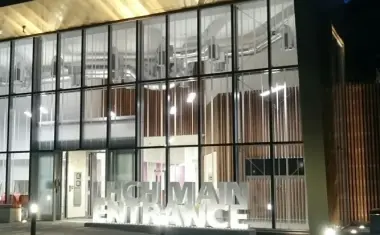Answering the Call for More Power, Access Capacity and Cost Efficiency
There’s an interesting confluence of trends in today’s security market, whereby security professionals are pressured to do more with less, while management pushes them for better ways to protect people, property and assets, and mitigate risks.

The development of new and improved ways to distribute more power, and design and deploy high-capacity, integrated system solutions is helping both security integrators and end users address these new challenges while lowering costs and increasing overall security.
Cost savings attributed to these new power and integration solutions are largely due to reductions in the amount of time and labor required to configure, assemble, and bench test new systems, as well as the time required to install and implement systems on-site. Power solutions, like 802.3bt PoE, have the ability to be converted and deliver power for physical security system deployments, and new maximum density access and power integration solutions require much less wall and rack space, conserving valuable real estate while increasing system capacity. Let’s explore the benefits of both...
More Power Wherever You Need It
Venues that occupy expansive amounts of space, such as warehouses, airports, malls, multi-housing units, and campuses, often require the installation of equipment closets in remote locations where AC power is not always readily available. With 802.3bt PoE, system integrators can leverage low-voltage installation and wiring methods to effectively eliminate the need for dedicated AC power circuits and related expenses. Instead, security devices can be powered over standard cabling without the need to run dedicated electrical wiring.
This latest PoE standard, 802.3bt PoE – also known as 4PPoE or 4-Pair PoE – is truly a game changer for the security market, enabling system installers to install power hungry IP devices easily and cost-efficiently. Simply put, 802.3bt PoE uses all four pairs of conductors to provide up to 90 W per port, which is a substantial increase in the maximum power over previous PoE standards. Power management is achieved using communication between the devices over the same connection cable. 802.3bt is also backward compatible, allowing users to upgrade their power source to this newer standard while using existing PoE devices, providing additional savings over the total cost of ownership (TCO).
By eliminating the need for high voltage inside the enclosure, 802.3bt PoE also does away with the cost of electrical permits, cabling, and dedicated conduit. The low voltage cable used for power can run in the same cable trays and paths as other network cabling which, for service and maintenance, eliminates the need for regulatory safety precautions, such as lock-out tag-out.
Another important feature of 802.3bt PoE is that there is no voltage present on the cable until it is plugged into a powered device and a handshake occurs. Unplugging the ethernet cable from the PoE-driven power supply is safe. Once the cable is plugged back in, the handshake is performed with the power source and PoE is delivered to a powered device.
The ability to use CAT6 cable to distribute both power and bi-directional data represents another significant cost-saving advantage. First, it allows the use of existing CAT6 infrastructure, which is now typically a mainstay of all new and/or renovated structures, without incurring the cost and labor of pulling new cabling. It also allows system designers and installers to install access, video, and other security devices wherever there is a cable feed, enabling fast and easy scalability when and if the need arises.
Using 802.3bt as an input to a power supply/regulator can simultaneously provide multiple output voltages, giving installers more flexibility when selecting and deploying devices. These new PoE driven power supply/chargers deliver a combination of voltage outputs, such as 12 V DC and 24 V DC simultaneously, to power a wide range of access, video, security, and fire devices.
Enhanced system troubleshooting is another important benefit of advanced 802.3bt PoE power supply/chargers. Products that report diagnostics via network communications can help determine the cause of a system failure. This information can effectively reduce system downtime, eliminate service calls, and provide faster response times to help keep security systems up and running. Advanced power and transmission solutions with network communications can also provide early detection of potentially failing devices, permitting service providers to take proactive measures to avoid system interruption.
The combination of faster design, installation and system troubleshooting and servicing translates into greater ROI for integrators, as installation labor costs and off-site service visits can be significantly reduced – and lower TCO for end users.
More Access and Power Integration
Access control is the new security imperative as organizations cope with changing work schedules, increases in crime, and heightened potential liabilities. It’s the perfect environment for the new generation of maximum density access and power integration solutions, which accommodate more access control hardware from leading provides with or without power. Available in high-capacity wall and rackmount models, these integration solutions dramatically increase access system capacities while lowering costs.
The simple yet pragmatic design of pre-configured or customizable access and power integration solutions makes an otherwise arduous task faster, easier, and extremely cost-efficient – all of which are tangible benefits for both end users and installers. Online configurator tools make the design process even easier, if not all but foolproof. Plus, the ability to test systems prior to deployment greatly reduces installation time and overall costs.
Space saving is a significant benefit provided by maximum density access and power integration solutions. In the past, multiple enclosures or racks were typically installed to house access control equipment, power supplies, and accessories. This requires a significant amount of valuable wall or rack space, versus an all-in-one access and power solution that provides ample room for all the required access and power products, and backup batteries.
Applications for maximum density access and power integration solutions include large venues with multiple doors commonly found in large commercial/industrial venues, hospitals, and multi-use properties. The deployment of these systems can greatly reduce the number of enclosures and space needed to provide the necessary access control to secure a facility.
Let’s compare a conventional 240-door access system with access control hardware in one enclosure and power in another, versus using a new maximum density access and power integration solution. The conventional system would require up to 30 enclosures employing 8-door access controllers and another 15 enclosures for power – totaling 45 enclosures. A maximum density access and power integration solution that accommodates up to 24 doors with power per enclosure reduces the number of enclosures to 10. This saves significant time, labor, and installation space, and makes servicing the system much easier by combining power and access control in far fewer enclosures.
In this new age of security where more is expected for less, it’s easy to see why new power and distribution solutions, combined with next generation maximum density access and power integration solutions, are finding favor with system designers and installers, and the end users they aim to please.














